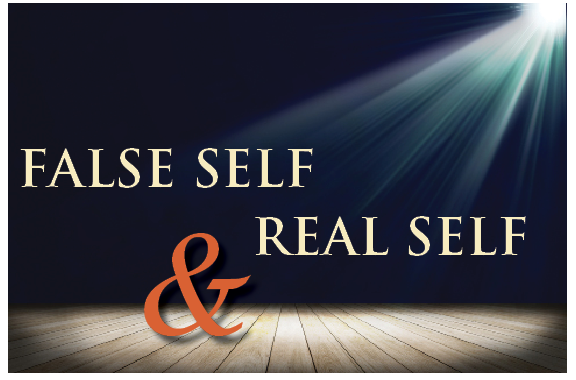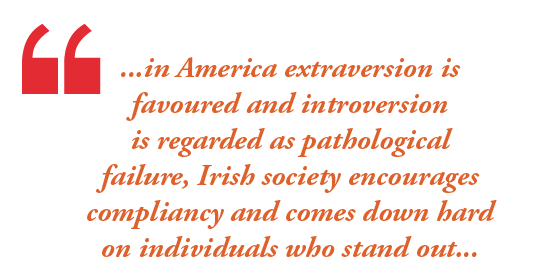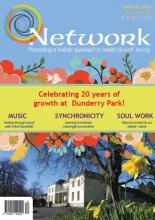False Self, Real Self - the games we play with our identity

It was the brilliant paediatrician D.W. Winnicott who coined the terms ‘False Self’ and ‘Real’ Self to describe how the sense of self that we regard as our identity is created or compromised from our earliest infancy onwards. Later on Alice Miller in her groundbreaking book ‘The Drama of Being a Child’ brought home to her readers the horror of the broken self, writing that for the child, the loss of the real self was experienced as an actual murder.
One of Winnicott’s profound contributions from his pioneering work on infant observation was the discovery that our first sense of self is born from the body. The baby is at first a bundle of disparate sensations without a unifying I, at the mercy of its intense needs and fears in all their rawness. It feels the anguish of hunger as a monster gnawing at its belly, abandonment as a falling apart, the lack of holding as a bleed-out through its dissolving boundaries. Winnicott wrote about the three aspects of mothering which knit the infant into a unit – holding, personalization, and object-presentation. With her sensitive and loving touch, the mother slowly puts the infant into its skin as it were, enabling it to feel that it is a unit rather than a random collection of flailing limbs, and literally mothers her baby into sanity.
Object-presentation is the term Winnicott used for describing how a mother protects her child’s sense of self against impingements such as disruptions in routine, rough handling, and loud noises. She presents reality in bite-sized chunks, ensuring that its state of going-on-being is not disrupted by chaos and confusion. Winnicott described this state as reverie, being rather than doing, and believed it to be the essence of the real self and all future creativity.
Winnicott used the term ‘the good-enough mother’ to describe the mother who would mirror her baby’s feelings and also receive its more violent and intense emotions – the hatred, rage and greed of its instinctual life – without rejection or reprisal. With this containment, the baby develops the conviction that it will survive its own destructive impulses without compromising the integrity the self.
When the infant reaches the toddler stage, the mother allows it to have the fantasy of omnipotence, to feel special and to be the centre of the universe. At this stage the infant needs to have its own version of reality, without any rude awakenings. It’s the perfect time for building castles in the air, being the prince or the princess, holding centre-stage. This is the phase of healthy exhibitionism, when the child’s feeling of omnipotence leads to a lifelong foundation for confidence, self-esteem and sense of worth, for being gloriously oneself. Winnicott deconstructs this process too: ‘The good-enough mother meets the omnipotence of the infant and to some extent makes sense of it. She does this repeatedly. A True Self begins to have life, through the strength given to the weak ego by the mother’s implementation of the infant’s omnipotent expressions’.
The fantasy of omnipotence creates the feeling that what moves us belongs to us, is our personal desire and impetus. It is the feeling that I myself feel this, I myself want this, which makes the experience uniquely mine and therefore real. The discovery that our body belongs to us (and later on our thoughts and feelings) is a crucial step before we start the complex business of inviting reality in to enrich us and to be enriched.
Being able to invite reality in without losing our sense of self is a magical state which Winnicott termed transitional space, a state where both the ‘I’ and the ‘not I’, inner and outer reality can exist simultaneously. This is the area of play, where we can create the world afresh, because our own reality and order enters into it. This is the meaning that lies at the heart of creation myths, when we create the world anew each time we enter into it with our innermost essence.
Winnicott termed this feeling as the exultant assertion of ‘I Am’. The joy and bliss of this state also becomes the foundation for the discovery of the big Self in adulthood, the archetype that Jung termed the Imago Dei, the Image of God within. Like the childhood real self, the Self contains the whole, it is our connection to the Divine, but also the repository of pure libido which flows out in a roaring stream towards the world, and lights up all of reality with its radiance.
Jung once described God as a super-abundance of reality. The Self connects us with a super-sensuous richness, a freshness of perception and feeling, a state that we would have approximated in childhood, and are left with only vague memories and yearnings for. In adulthood we undertake the journey of self-realization or individuation as a process of connecting with the archetype of the Self, and rediscovering the magic of childhood in the process.
Jung often emphasized that to be true to ourselves, we had to connect with our muddy roots, our flesh and blood biological reality. Winnicott’s work on the origin of the self in the body, of creativity and reverie rooted in childhood play, has profound consequences for healing the age-old split between body and soul, showing us that they are aspects of the same reality, one and indivisible.
The I Am of reverie becomes the foundation for the ultimate celebration of the Self in the state of Samadhi, when the I Am becomes the That Art Thou (Tat Tvam Asi) the union of the Self with the Absolute, when there is no longer any distinction between the known, the knower and the knowing. Because this state of ultimate self-realization is founded in the humblest, the most ordinary, and most easily over-looked aspects of our lives, it overturns the narcissistic pretensions of the ego and counteracts the inflation of its puffed up dominance.
Winnicott used the term ‘False Self’ to describe what happens when there are cracks in the process which knits us together into an authentic I. These cracks are caused by failures in any of the different aspects of mothering and the environment. They result in the existential terrors of annihilation anxiety, falling apart and nameless dread, very much like Humpty Dumpty whom even all the King’s Horses and all the King’s Men could not put together again.

The greatest damage to the child’s Real Self occurs when the mother is not able to meet its need for omnipotence, its feeling that it is the creator, the architect of its world. As Winnicott writes: ‘The mother who is not good enough is not able to implement the infant’s omnipotence, and so she repeatedly fails to meet the infant’s gesture, instead she substitutes her own gesture which is to be given sense by the compliance of the infant. This compliance on the part of the part of the infant is the earliest stage of the False Self and belongs to the mother’s inability to sense her infant’s needs. Through this False Self the infant builds up a false set of relationships… so that the child may grow up to be just like mother, nurse, and brother, or whoever dominates the scene. The False Self has one positive and very important function: to hide the True Self, which it does by compliance with environmental demands.’
As children we continue to acquire layer upon layer of the False Self in response to demands by our parents, teachers and the environment to become a particular kind of person. When we start becoming aware of the False Self we realize that many of our values, feelings and thoughts are not our own. They are ideals and voices we have introjected from the past, and from the collective. Each society has its mould for its members – in America extraversion is favoured and introversion is regarded as pathological failure, Irish society encourages compliancy and comes down hard on individuals who stand out; rural societies everywhere are contemptuous of sensitive people. In the family unit too, some traits are favoured over others, parents might prefer their son to become an engineer rather than an artist, or value a safe pensionable job over a risky entrepreneurial one.
Jung once wrote that ‘children are condemned to live out the unlived life of their parents’. Children absorb their parents’ unfulfilled ambitions and regrets at an unconscious level and will sacrifice their own individuality to become the perfect golden child or rebel wildly against the psychological oppression even to their own detriment.
Most of our problems in later life, of depression, addiction, anorexia, obsessive-compulsive disorders and anxiety are the result of losing the connection to the real self and therefore to healthy instincts and the archetypal base of our nature. Lacking this base, we feel empty, dispossessed, and driven to fill the hunger with fantasy and false identifications. Consumerism makes cunning use of our disconnect with ourselves, hijacking and denaturing our instincts to serve its own ends. It gives us the illusion that we can substitute our longing for love and validation with objects (be they cars, the body beautiful or cruises), using them as fetishes, hoping that their glamour and manna will rub off on us. This scooping out of inner riches and replacing them with dead objects is the hallmark of narcissism. Our increasing sense of emptiness fuels the drive for more meaningless acquisitions which lead to further despair and so the vicious cycle continues.
We also try and compensate for the sense of worthlessness by developing a false feeling of grandiosity and inflation, trying to convince ourselves that we are special. This sense of entitlement is buoyed up by the collective culture and so we inevitably collude with the mass delusion of a celebrity life and sacrifice our time, relationships and our connection to nature and reality in the pursuit (which the unconscious compensates with typical humour, by sending us dreams of filthy, overflowing toilets - the most common dream of our narcissistic times).
On the milder end of the spectrum, we all deploy the false self to play the game of the world. This is the persona or mask that we wear in order to oil the wheels of social interaction, helping others to ‘place’ us, particularly in our professional capacity. We expect a doctor or a teacher, a banker or an artist to look and behave in a particular way, and if they don’t we find it quite disconcerting, and label them yet again, as eccentric! Though the persona can serve us well, protecting the real self, it becomes a problem when it is too rigid or if we over- identify with it. It can then become a lie, disconnecting us from the real self, very much the mask which hides the true self. Over-reliance on personas can lead us to think in stereotypes, reducing the complexity of our natures to a mere caricature and encouraging projections and prejudices.
In dreams, the state of our persona is represented by clothes. The classic dream of discovering ourselves naked in public usually occurs when a new adaptation is required. It means that we are feeling vulnerable and exposed without an adequate defense. Of course if we feel perfectly comfortable being naked it means that we are living from the real self. Shopping for new clothes is a pleasant activity in a dream, when we are in the process of redefining our presentation to the world. These dreams can be quite light-hearted and fun, and we should not take the persona too seriously anyway.
In the Upanishads and in the Hermetic texts, the Self is described as ‘the smallest of the small and the biggest of the big’. It encompasses the full gamut of existence, knitting together the phenomenal and the Absolute. We experience it as play, spontaneity, humour, creativity, compassion, physical health and vigour, happiness, generosity and compassion, wonder, curiosity, love, epiphany and rapture. Because the Self unites matter and spirit, it can create synchronicity, the chance happenings where circumstances come together as if by magic to put us in the right place at the right time, send us prophetic dreams, take us to distant places, unite us with loved ones who are long gone, even awe us with miracles, all events which the Self can effect because it can transcend (and even bend!) the rules of space, time, and causality. In world mythology as in our dreams, the Self manifests as the divine child - which becomes the ultimate symbol of the real self – whose very vulnerability and plight confers upon it the power to move the world.
When he was asked if individuation would make one suffer less, Jung famously replied, ‘no, we will suffer more intensely, but our capacity for suffering will increase’. We’ve all experienced how being able to mourn allows one to feel more deeply in every aspect of life, and how it connects us back to ourselves and others.
‘Humankind cannot bear very much reality’, T.S. Eliot wrote. But the ways in which we shield ourselves from reality can create their own suffering. We have to slowly learn to accommodate more reality.

Jasbinder is Chairwoman of the C.G. Jung Centre - The All-Ireland Centre for Jungian Studies. The Centre holds workshops and lectures as well as The Certificate Course in Jungian Studies.
Jasbinder will also be running the Diploma Course in Consciousness Studies. This is a pioneering course integrating Jungian depth-psychology with Vedic techniques for Self-Realization.
You can contact Jasbinder via
www.jungcentre.com
[email protected]
Phone: 083-7610354
Latest Issue
Upcoming Events
-
17/04/2020 to 26/04/2020
-
18/04/2020
-
23/04/2020
-
15/05/2020 to 23/05/2020
-
16/05/2020 to 17/05/2020
Recent Articles
Article Archive
- November 2011 (2)
- January 2012 (3)
- February 2012 (2)
- March 2012 (2)
- April 2012 (4)
- May 2012 (4)
- June 2012 (1)
- July 2012 (3)
- August 2012 (2)
- October 2012 (2)

